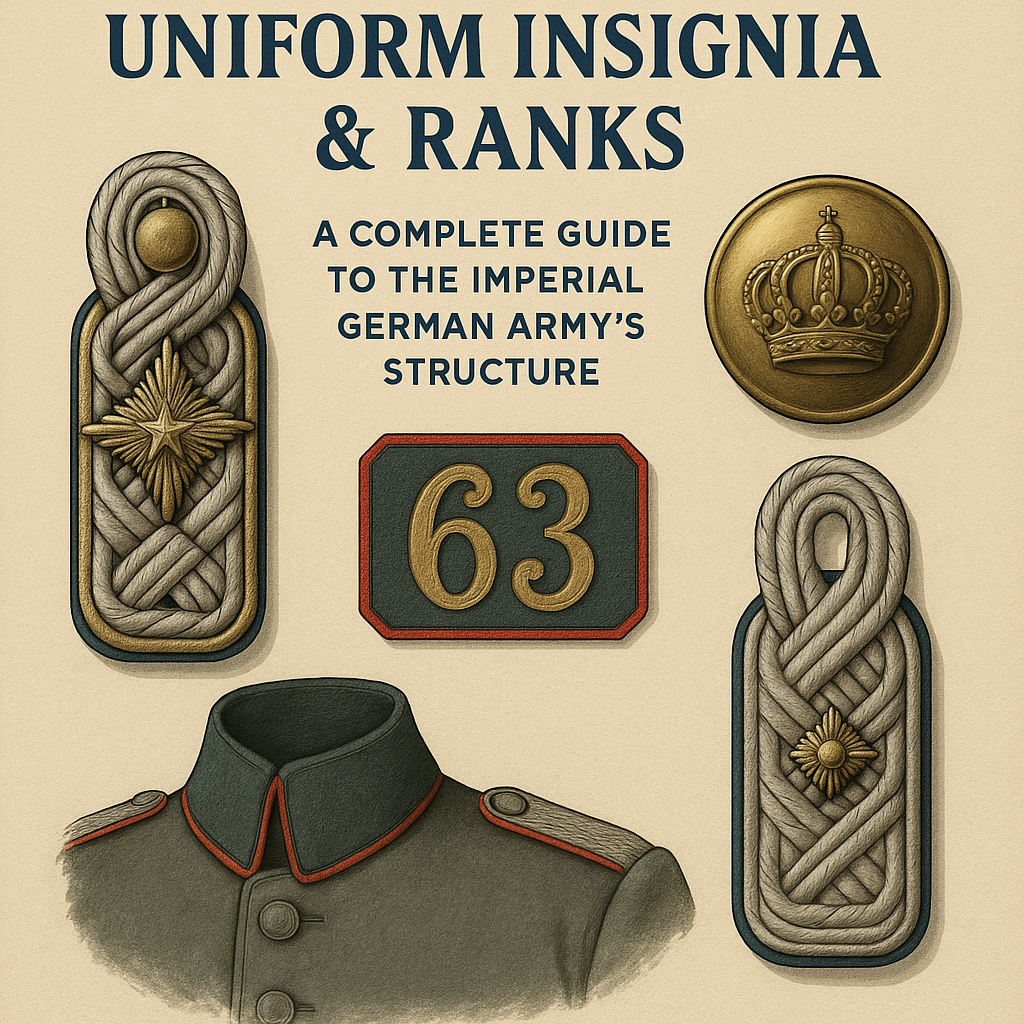
WWI German Uniform Insignia & Ranks: A Complete Guide to the Imperial German Army's Structure
Published on May 11, 2025
WWI German Uniform Insignia & Ranks: A Complete Breakdown
Uniforms and insignia are more than just clothing and decoration—they are the visual language of military hierarchy, tradition, and pride. In the case of the Imperial German Army during World War I, this language was especially rich in symbolism and structure. Each rank was clearly marked with specific elements, helping soldiers and officers quickly identify each other's positions, responsibilities, and units.
In this article, we’ll explore the rank structure, insignia styles, and the often-overlooked WWI buttons that played an integral role in German military attire.
1. The Rank Structure of the Imperial German Army
The German Army before and during World War I followed a detailed rank structure derived from long-standing Prussian military traditions. This structure included commissioned officers, non-commissioned officers (NCOs), and enlisted ranks.
Commissioned Officer Ranks
These were the leaders and decision-makers within the Imperial German Army. Their ranks were often denoted through ornate shoulder boards, collar tabs, and chest insignia.
- Leutnant (Second Lieutenant) – Entry-level officer rank.
- Oberleutnant (First Lieutenant) – Junior officer, typically second in command of a company.
- Hauptmann or Rittmeister (Captain) – Commanded companies; Rittmeister was used for cavalry units.
- Major – Responsible for battalion-level command.
- Oberstleutnant (Lieutenant Colonel) – Often led a regiment.
- Oberst (Colonel) – Senior officer in charge of large regiments.
- Generalmajor (Major General) – Oversaw brigades and divisions.
- Generalleutnant (Lieutenant General) – Higher-level strategic command.
- General der Infanterie/Kavallerie/Artillerie – Denoted generals in specific branches.
- Generaloberst (Colonel General) – One step below Field Marshal.
- Generalfeldmarschall (Field Marshal) – The highest rank, reserved for top commanders and royalty.
These officers wore braided cords, pips (stars), and embellished collar patches, all of which were crucial to identifying their exact role and authority on the battlefield.
2. Non-Commissioned Officers and Enlisted Ranks
The NCOs formed the backbone of the army, serving as a critical bridge between enlisted men and commissioned officers. Their insignia was less ornate but still clearly visible and highly respected.
Common NCO Ranks
- Unteroffizier (Corporal) – A basic NCO who often led small units.
- Sergeant – Similar to modern sergeants, played a supervisory role.
- Vizefeldwebel (Vice Sergeant Major) – A senior NCO rank.
- Feldwebel (Sergeant Major) – Managed discipline and training.
- Offizierstellvertreter (Deputy Officer) – A unique transitional rank between NCO and officer.
NCOs typically wore tree (silver or grey braid) on their collars or cuffs and carried sidearms to signify authority.
3. Enlisted Men’s Uniforms and Rank Markings
Enlisted soldiers had the most simplified uniforms but still displayed unit affiliation and service length. Their collars and shoulder straps often included coloured piping, numbers or symbols to indicate regiment, and sometimes rank indicators like chevrons or armbands.
4. The Significance of WWI German Uniform Insignia
German uniform insignia served multiple purposes:
- Identification – On chaotic battlefields, insignia made it easy to recognise ranks.
- Pride and Tradition – Many units had insignia reflecting regional or historical heritage.
- Morale – Decorations and symbols fostered unity and pride within a unit.
Insignia came in several forms:
- Shoulder Boards – Used mainly for officers; featured braiding and pips.
- Collar Tabs – Colored fabric with embroidery, often branch-specific.
- Cuff Titles – Later popularized in SS uniforms in WW2, but early forms existed.
- Chest Badges – Awarded for valor or special achievements.
5. WWI Buttons: Small but Significant
Often overlooked, WWI buttons played a surprisingly important role in uniforms. Not only did they secure tunics and coats, but they also indicated rank, unit, and even geographic origin.
Materials and Designs
- Brass – Most common in early WWI uniforms.
- Steel or Zinc – Used later due to material shortages.
- Embossed Symbols – Prussian eagles, crowns, or unit numbers were often featured.
Historical Importance
Collectors value these buttons highly, especially those marked with specific regimental numbers or early pre-war crown designs. Some even featured the rimless crowned design that became popular in mid-war tunics around 1915.
6. Comparing WWI with WWII Insignia (Pillar Page Context)
Your site’s pillar page—WW2 German Officer Ranks—shows a natural evolution in German uniform structure. WWII insignia, especially within the SS (Schutzstaffel), were much more elaborate. Items like the SS emblem, rune patches, and cuff titles had psychological and symbolic weight beyond traditional military rank.
In contrast, WWI insignia remained functional, rooted in Imperial tradition rather than ideological symbolism.
7. Uniform Variations by Branch
Each branch of the German Army—infantry, cavalry, artillery, etc.—featured slight variations in their uniforms:
- Infantry – Field-grey tunics, red piping, standard issue shoulder boards.
- Cavalry (Uhlans and Hussars) – More ornate, with pelisse jackets and colourful insignia.
- Artillery – Black or dark blue collar tabs with red trim.
Even within the same branch, regional differences (Bavarian, Saxon, Prussian units) affected insignia style and button design.
Conclusion
The study of WWI German uniform insignia and ranks provides a fascinating glimpse into the disciplined and complex structure of the Imperial German Army. Whether through shoulder boards, collar tabs, or uniform buttons, each piece played a critical role in communication, identification, and military cohesion.
For collectors, historians, and enthusiasts, these details offer more than aesthetic appeal—they tell the story of an army that shaped 20th-century warfare. With your website offering products like World War 1 military buttons, Waffen SS insignia, and more, this context helps visitors understand the historical significance of the items you sell.
